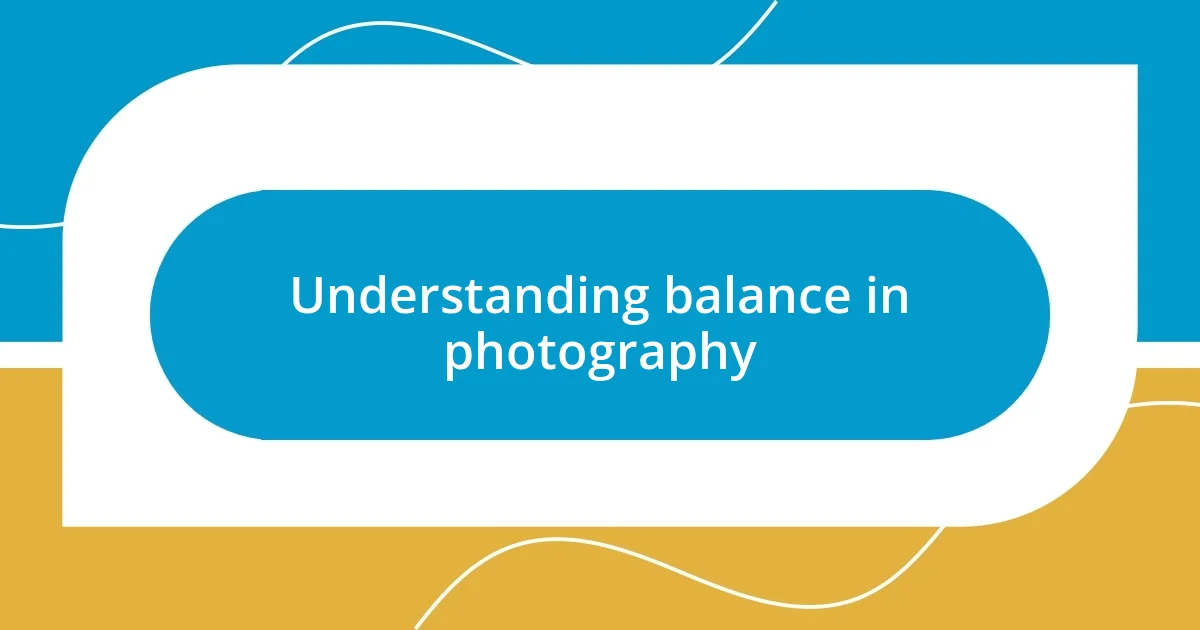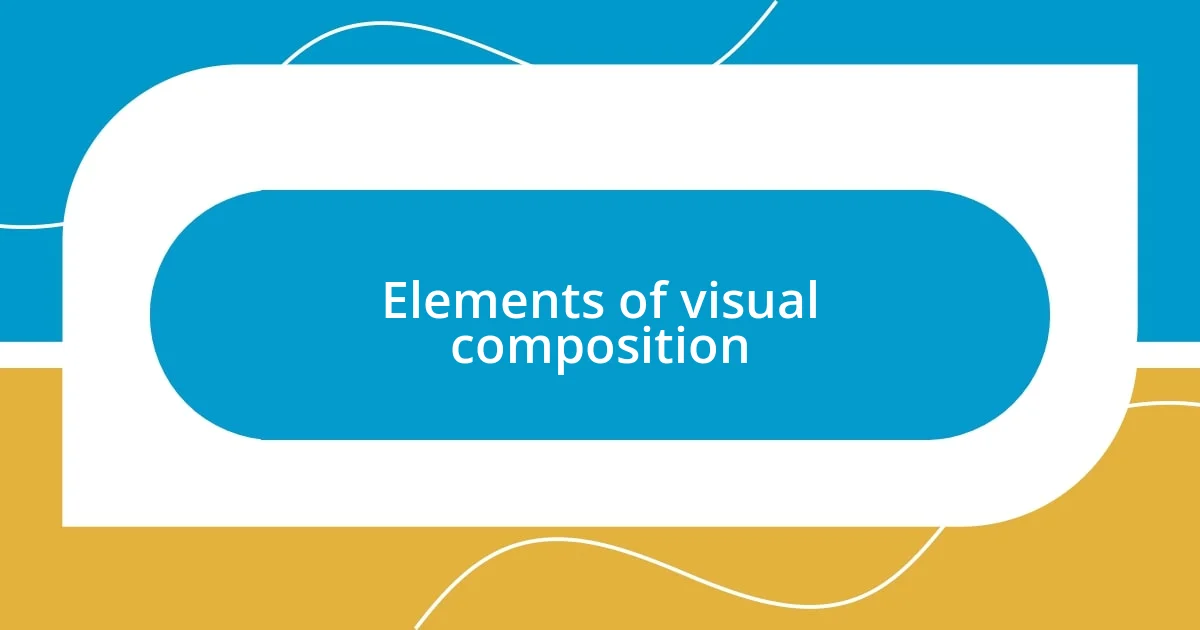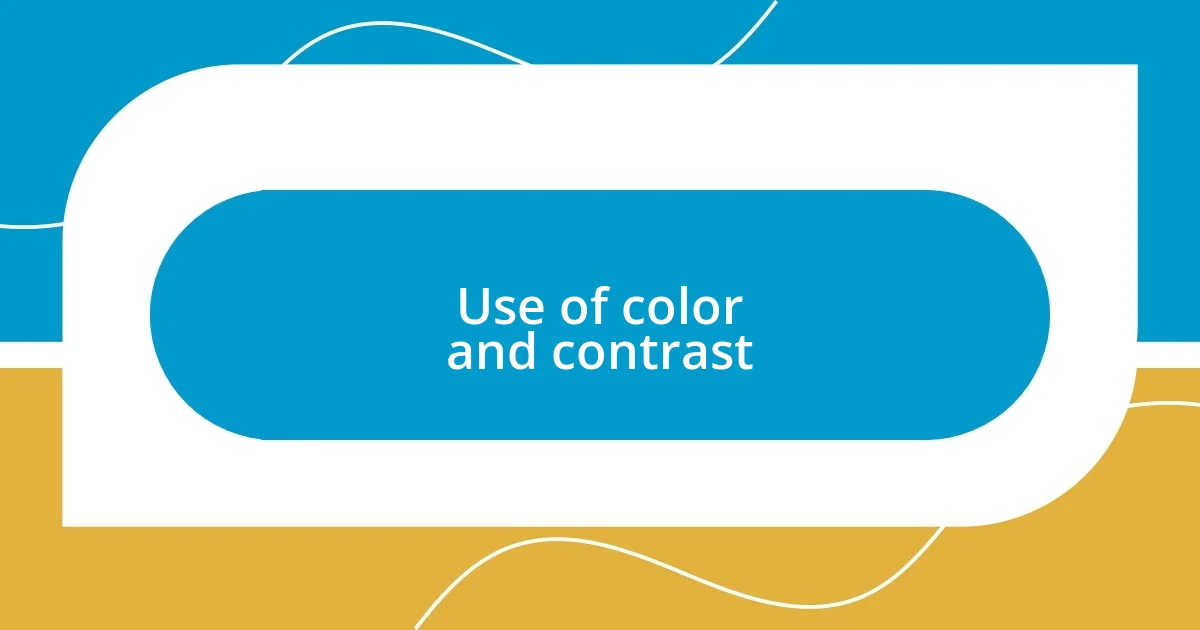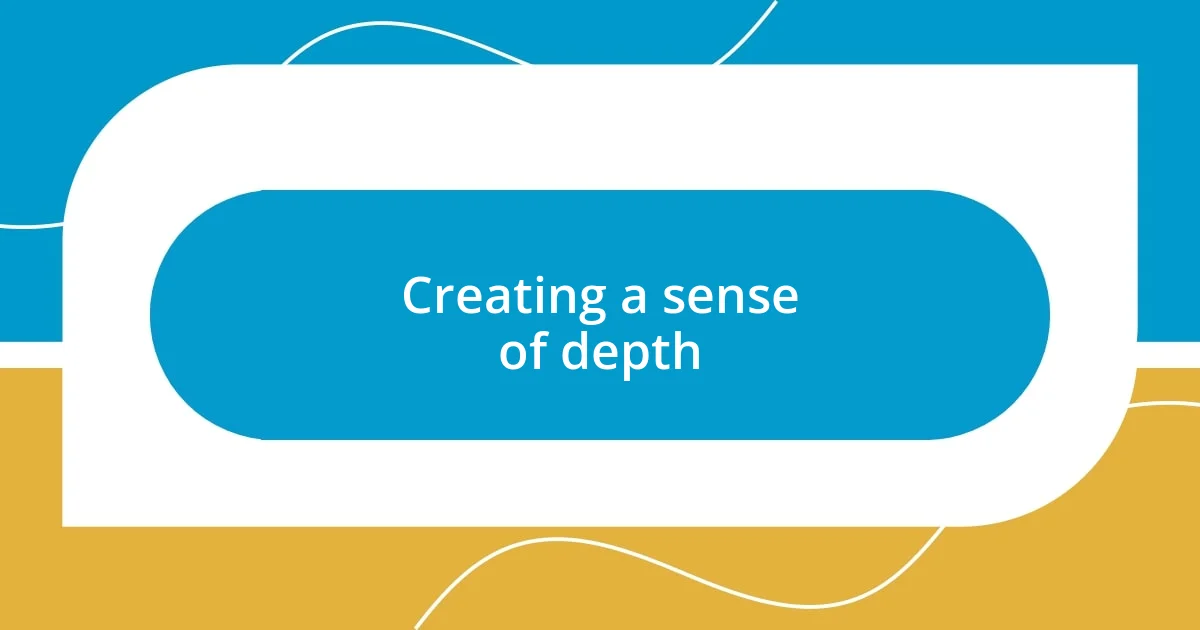Key takeaways:
- Balance in photography enhances visual appeal by ensuring elements interact cohesively, impacting the viewer’s emotional experience.
- Key visual composition elements include line, shape, color, texture, and space, which all contribute to creating a compelling narrative.
- Techniques like the rule of thirds, layering, and utilizing color contrast can significantly deepen the impact and storytelling of an image.

Understanding balance in photography
Balance in photography can transform an ordinary image into something captivating. I remember the first time I captured a sunset over a calm lake; the symmetry of the reflection created a harmony I hadn’t fully understood before. It made me realize that balance is not just about visual symmetry but also about how elements within the frame interact and complement each other.
Have you ever looked at a photo and felt that something was amiss, even if all the elements were technically correct? That’s often the lack of balance at play. I had this moment during a photography workshop when I paired a vibrant flower with a stark, empty background. It was beautiful, but the flower seemed lost, disconnected, highlighting how different elements must work together to create a sense of peace and cohesion.
Thinking about balance also makes me ponder its emotional impact. When I frame a shot, I often ask myself, “What story do I want to tell?” For example, an off-center object can evoke tension, drawing the viewer’s eye and creating a dynamic feeling. Understanding these nuances creates a more immersive experience for the viewer, allowing them to feel the emotion embedded in the frame.

Elements of visual composition
Elements of visual composition play a crucial role in how a viewer perceives a photograph. When I think about composition, I recall a moment when I was photographing a bustling city street. I noticed how the alignment of buildings, people, and light sources influenced the overall mood of the image. It was then I realized that composition is not just about placing objects, but about creating a narrative through arrangement.
Here are some key elements of visual composition to consider:
- Line: Guides the viewer’s eye through the image, creating movement and direction.
- Shape: Contributes to the overall structure and balance, often forming the foundation of your composition.
- Color: Evokes emotion and can create harmony or contrast, impacting the viewer’s response.
- Texture: Adds depth and interest, making a photograph more engaging.
- Space: The use of positive and negative space effectively can enhance your subject’s presence.
Reflecting on these elements has often inspired me to experiment with unconventional framing. For instance, while shooting a portrait, I decided to include more negative space, which intensified the subject’s emotions by emphasizing their expression within a broader context. It’s fascinating how each component intertwines to create a cohesive story that resonates personally with both the photographer and the audience.

Techniques for framing subjects
When framing subjects, one effective technique is utilizing the rule of thirds. This means dividing your image into a grid of nine equal parts and positioning the key elements along these lines or intersections. I still remember the day I experimented with this while photographing a lively street fair. By placing the main subject off-center, a juggle of vibrant colors and movement emerged, making the photo feel much more dynamic and inviting. The slight shift transformed a simple scene into a captivating story.
Another approach I find useful is creating layers within the frame. This technique adds depth and perspective to your images, guiding the viewer’s gaze through different elements. I once captured a scenic view of a mountain range, framing it through the branches of a nearby tree. This created a natural frame within the frame, emphasizing the breathtaking backdrop while offering a sense of intimacy. It reminded me that every layer in a photograph has its own story to tell, contributing to the overall narrative.
Lastly, using leading lines can dramatically enhance the composition of a subject. These lines draw the viewer’s attention to the focal point of an image, making it feel more engaging. For instance, during a recent trip to the coast, I photographed a winding path leading towards the ocean, which naturally drew the eye toward the horizon. I love how lines can serve as visual guides, helping viewers navigate the scene while adding a sense of adventure to the experience.
| Technique | Description |
|---|---|
| Rule of Thirds | Position key elements along a grid to create balance and focus. |
| Layering | Add depth using foreground, middle ground, and background elements to create a rich narrative. |
| Leading Lines | Use natural lines to draw attention and guide the viewer’s eyes to the subject. |

Use of color and contrast
When it comes to color and contrast, I’ve learned that they can dramatically influence the mood of a photograph. During one of my hikes, I captured a sunset where the intense oranges and purples created a dreamy, ethereal effect. However, I found that pairing these vibrant hues with the cool blues of the shadowed mountains added depth and intrigue, drawing the viewer into a more complex emotional experience. Isn’t it amazing how a simple shift in color palette can change the entire narrative of an image?
Contrast isn’t just about opposing colors; it’s also about the relationship between light and dark. I distinctly remember snapping a portrait of a musician under harsh stage lighting, which illuminated their features dramatically against a dark backdrop. This stark contrast not only accentuated their passionate expression but also evoked a sense of urgency and energy. Have you ever felt drawn to a photograph simply because of its striking differences in light? I often find that such contrasts create a visual tension that invites the viewer to linger.
Finally, thinking about color theory can be a game changer. I once experimented with complementary colors while photographing flowers in a vibrant garden setting. By incorporating contrasting shades, like deep violets paired with bright yellows, the flowers truly popped off the frame. It got me thinking—how often do we overlook these simple principles in our work? Using contrasting colors strategically can elevate your images, making them not just seen, but felt.

Creating a sense of depth
Creating a sense of depth in my photographs brings a new dimension to my work, and one of my favorite techniques is the use of atmospheric perspective. I vividly recall a misty morning when I snapped a shot of a valley layered with fog, gradually revealing the distant hills as they emerged from the haze. This natural gradient created a genuine sense of distance and depth that filled me with awe at that moment. Have you ever felt transported by an image that seemed to stretch far beyond what your eyes could see?
Another effective approach is scale and proportion. During a recent trip to a bustling city, I took a photo of towering skyscrapers next to tiny street vendors. Capturing this juxtaposition inspired a feeling of smallness, making the viewer almost become part of the scene. Scaling elements against each other adds visual interest and layers; it leads to a richer storytelling experience. When you embed scale into your compositions, how does it shift your connection to the moment?
Lastly, incorporating shadows can enhance depth dramatically. I experimented with shadow play one afternoon under an old tree filled with sprawling branches. As the late afternoon sunlight filtered through, the intricate patterns cast by the leaves created a tapestry of light and darkness on the ground. This not only added depth to the photo, but also introduced a sense of mystery. It’s fascinating how light, in tandem with shadow, can evoke such an emotional response. What stories do you think shadows tell in your own photography?

Tips for achieving symmetry
Achieving symmetry in photography can transform an ordinary shot into something striking. I remember walking through a serene temple garden, where the perfectly mirrored reflection of the structure in the pond captivated me. It’s incredible how that effortless balance just pulled the viewer’s gaze directly to the center, sourcing a feeling of harmony. Have you ever experienced that calming effect from a symmetrically composed image?
One trick I love is utilizing natural or architectural lines to guide the eye. I often find myself drawn to long hallways or roads that create symmetry through leading lines. On a recent urban exploration, I photographed a pair of street lamps flanking a cobblestone path. The parallel lines not only emphasized the symmetry but also created a sense of depth, making the viewer feel like they could walk right into that lovely setting. Isn’t it fascinating how simple elements can evoke such a strong sense of place?
Keep in mind that symmetry can also be achieved through the careful placement of subjects within the frame. While capturing a quiet lakeside moment, I positioned a canoe centered on the water, perfectly attentive to the trees reflecting on either side. Witnessing that balance brought an undeniable tranquility to the image. Reflecting on your own work, aren’t there moments where you see symmetry and it feels like everything just clicks into place?














